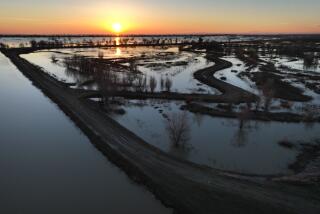State turns to farmers for water
- Share via
SACRAMENTO -- — Saying California’s water reserves are all but gone, state officials on Thursday announced the revival of a dormant 17-year-old program to buy water from Sacramento Valley farmers and sell it to the thirstiest Southern California agencies in case this winter brings a third year of skimpy precipitation.
“We’re hoping for the best, that we’re going to have a good storm season and be able to meet the needs of California,” said state Department of Water Resources Director Lester Snow. “However, we would be negligent if we didn’t prepare for the worst.”
The bounty of the state’s biggest reservoirs, which supplied the state through the last two dry years with Sierra and Cascade mountain snowmelt, is disappearing. Major reservoirs, including Shasta Lake and Lake Oroville, are now at half of what is typical for this time of year.
“There are a number of scenarios where we do not regain our snowpack,” Snow said, “and because our storage is low, we’re really in a lot of trouble.”
State officials said long-range climate predictions indicate that this winter may bring average precipitation or less.
“We do have time as we go through the season to make up for the last two years,” said state water resources meteorologist Elissa Lynn, “but it would take a wetter-than-average year. None of the climate models that we have right now suggests a very wet start to the season.”
The state last used a water bank in 1991 and ‘92, the final critically dry years in a six-year drought. The state served as broker and deliveryman. The Department of Water Resources found volunteer farmers who either skipped growing crops, switched to less thirsty crops or pumped groundwater instead of diverting river water. The state then purchased the freed-up water for prices ranging from $30 to $125 an acre-foot (roughly enough water to supply the annual needs of two households).
Most sellers were farmers within districts that hold generous, century-old water rights on the Sacramento, Yuba and Feather rivers. Most buyers were urban water districts in the San Francisco and Los Angeles areas and irrigation districts in the San Joaquin Valley. The biggest buyer in 1991 was the Metropolitan Water District of Southern California, which wholesales water from Ventura to San Diego counties.
The MWD expects to tap the bank again if next year is dry, said general manager Jeffrey Kightlinger.
“We will definitely participate in it,” he said.
But there may not be so many willing sellers in the coming year.
Farm commodity prices are high, giving farmers more incentive to grow crops, especially rice. And several Northern California counties passed ordinances to restrict groundwater pumping after the experience of the last water bank, when excessive pumping drew down aquifers and forced the neighbors of some water sellers to dig deeper wells.
No water agency sold more to the state water bank in 1991 than the Western Canal Water District, which serves rice farmers in Butte and Glenn counties. But general manager Ted Trimble said things are different now.
He noted that in February his district had arranged to sell water at $200 an acre-foot to Southern California water districts in a deal separate from the state water bank. But when the price of rice more than doubled in March, Trimble said, almost half of the growers who were going to forgo planting some acres changed their minds.
“I just don’t know how much water we’re going to be able to make available to make a difference,” Trimble said.
As the broker, Snow said, the state will sell first to districts struggling with drought-related health or public safety problems.
“We as a state entity looking out for the broader good,” he said, “are not going to allow somebody to have 100% supplies and be hosing off sidewalks while a community has no fire protection and poor quality water to drink.”
--
More to Read
Sign up for Essential California
The most important California stories and recommendations in your inbox every morning.
You may occasionally receive promotional content from the Los Angeles Times.










